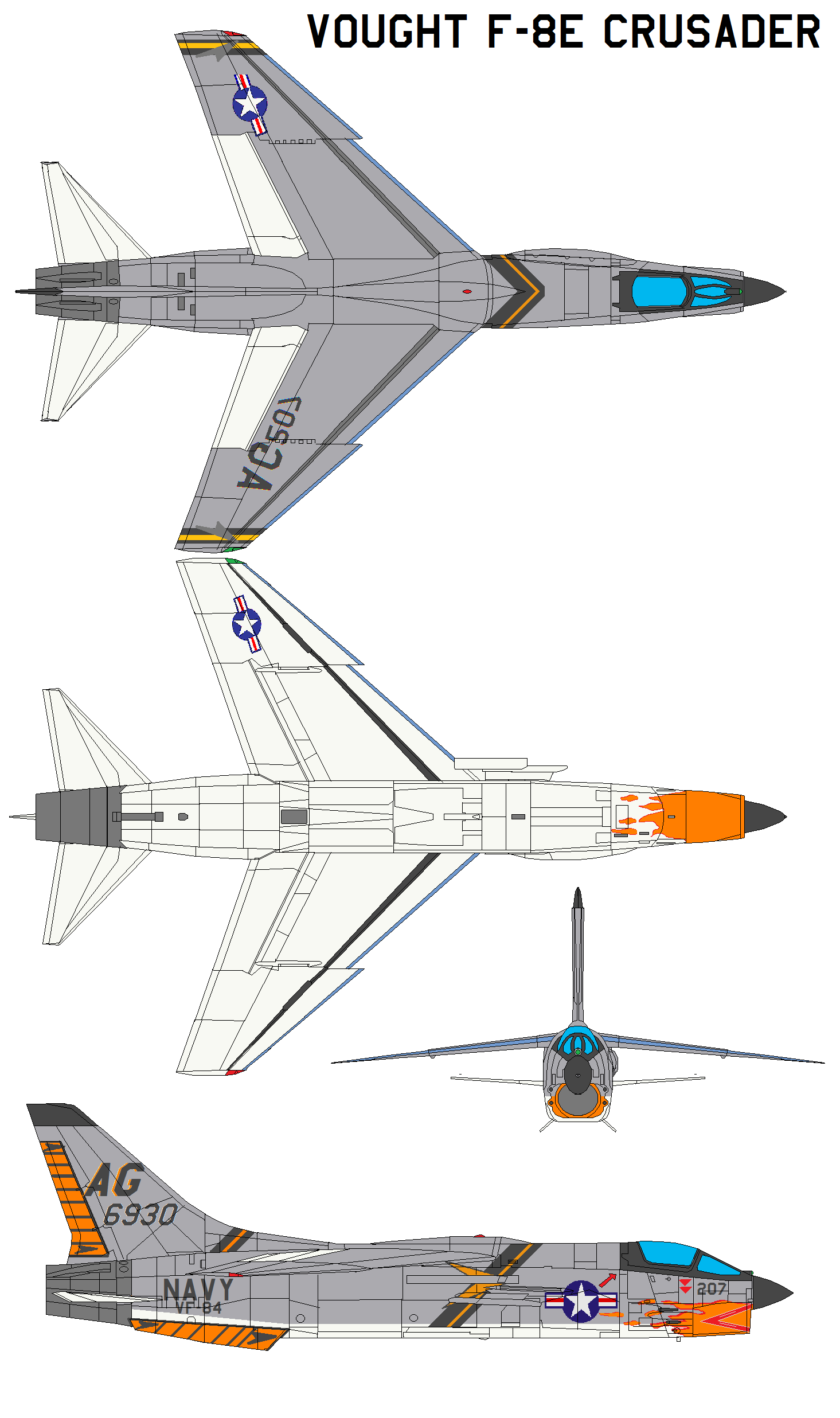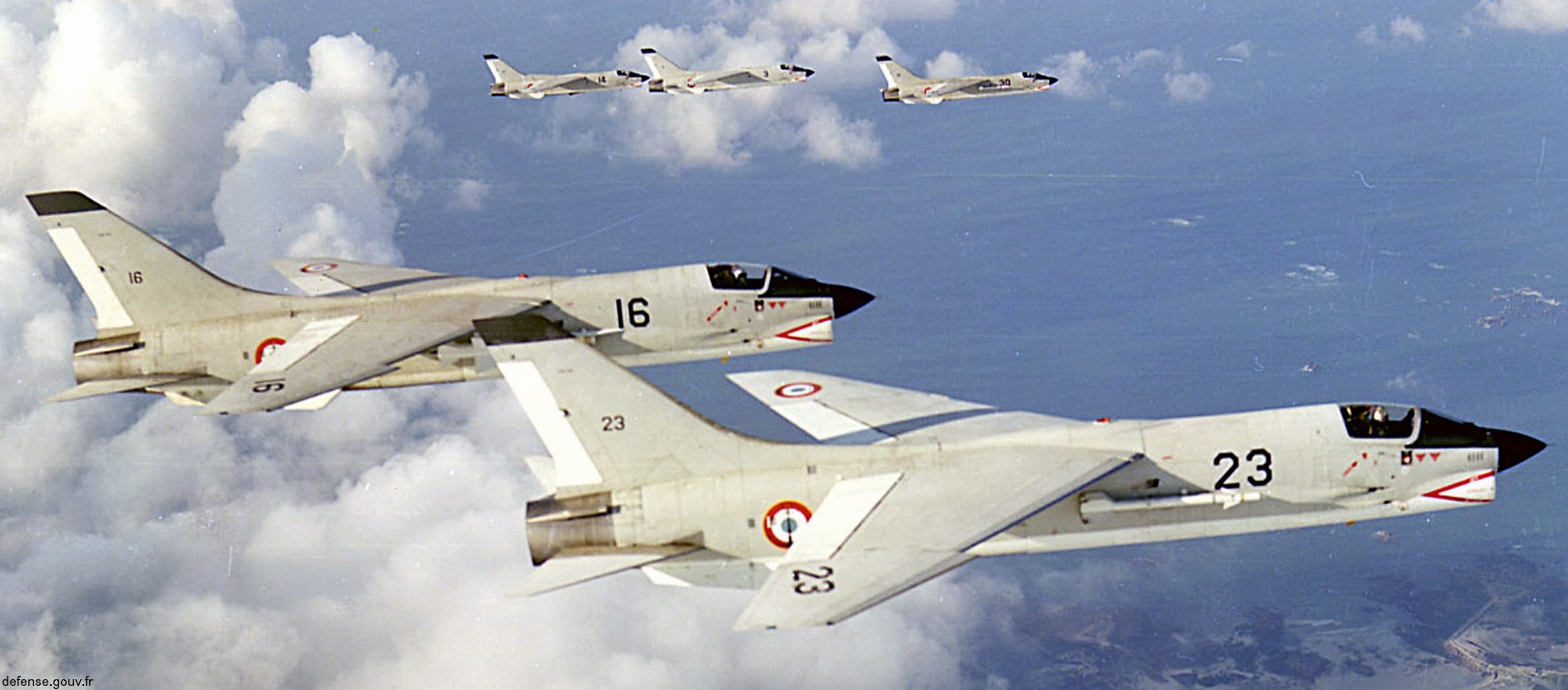F-8 Crusader Wing - This article requires additional citations for verification. Please help improve this article by adding citations to reliable sources. Unverifiable content may be challenged for removal. Find sources: "Variable incidence arm" - News·Newspapers·Books·Academics·JSTOR (November 2009) (learn how and what to remove from this template message)
A variable angle-of-attack wing has an adjustable angle of attack relative to its main body. This allows the wing to operate at high angles of attack during takeoff and landing, while allowing the fuselage to remain close to level.
F-8 Crusader Wing
Pivot mechanisms add extra weight and cost over traditional arms, but in some applications the benefits may outweigh the costs.
Eduard 1:48 F 8e Crusader (ed11110) Review
Some early aircraft had wings whose angle of attack could be varied for control and trimming, rather than traditional elevator control surfaces. Wing warping alters the incidence of the outer wing and was used by several pioneers including the Wright brothers.
Early examples of rigid wings with variable angle of attack were not particularly successful. They include the Mulliner Knyplane in 1911, the Ratmanoff monoplane in 1913 and the Pasul Schmidt biplane, also in 1913.
On May 20, 1912, Bulgarian inventor George Boginoff achieved the breakthrough of the variable incidence rigid arm in France.
The first example to be made in any quantity was the Frch tandem wing Mignet Pou du Ciel (Fly Flea), which became somewhat popular in the 1930's. It had a variable-incidence front wing, which proved unsafe and was discontinued after a series of fatal accidents.
F 8 Crusader
During World War II, the German company Blohm & Voss developed variable-angle-of-attack monoplanes to provide greater takeoff lift because the rear fuselage was too close to the ground to allow the entire aircraft to rotate.
The fuselage of the prototype BV 144 transport aircraft was lowered into a shorter landing gear, allowing passengers to get on and off the plane without additional steps. Another proposal from B&V was the P 193 attack aircraft, which was in a propeller configuration and could not spin the fuselage for takeoff without touching the propellers, so it was equipped with variable angle-of-attack wings.
Russian designer S. G. Kozlov designed the E1 variable angle-of-attack fighter, but the unfinished prototype was destroyed when the factory was occupied by Germany in 1941.

Carrier aircraft must have good forward visibility during descent and approach deck landing. Without a variable angle-of-attack wing (or other high-lift device), the pilot would have to lift the plane's tires to maintain lift at the slow approach speeds required, which would limit forward visibility. By increasing the angle of attack of the wings rather than the fuselage, high lift and good forward visibility can be maintained. The setup also avoided the need for a long and heavy nose gear to increase the takeoff angle of attack. The Supermarine Model 322 prototype first flew in 1943, and the Seagull ASR.1 amphibious water craft first flew in 1948.
Where Can You Go In An F 8? Not Far
After the war, America revisited the idea of the jet age. Martin XB-51 bombers and Republic XF-91 interceptors use variable angle of attack for much the same reason as B&V. Both first flew in 1949, but only a few prototypes were built. It was followed by the 1955 Vought F-8 Crusader, the only variable-incidence fighter to enter production and enjoy a successful service career. Fortunately, the program was canceled before one of NASA's swept-wing F-8s could actually be fielded. What a horrible thing to do to "The End of the Arms" from an ascetic point of view!
One of the most capable fighter jets of the post-World War II era, the F-8 Crusader's elegant design featured open air intakes under the fuselage and variable-incidence wings that could Take off while maintaining good visibility for the pilot. In an era when fighter pilots were increasingly reliant on rockets, the Crusader carried a 20mm cannon, prompting its pilots to dub it "the gunner of last resort".
During the Cuban Missile Crisis in October 1962, as part of a photo reconnaissance flight over Cuba, the Crusaders flew their first combat mission, firing cameras instead of guns. The F-8 also logged these missions, as well as attack and combat air patrol flights throughout the Vietnam War. Crusader pilots are credited with shooting down 18 enemy MiGs in dogfights.
NASA also flew several modified F-8s in the early 1970s, demonstrating the feasibility of fly-by-wire digital technology (using data processing equipment adapted from the Apollo guidance computer) and supercritical wing designs.
Happy Birthday To The Vought F 8 Crusader
As Admiral Paul T. Gilchrist explains in his book The Crusader, an F-8 was almost also used as a test machine for the oblique wing concept! : Update from Gunfighters: "He was shot twice when he walked in the door of my office at the Pentagon. He was an acquaintance, not a friend, a retired Crystal City rear admiral who admitted to being injured." Employed by Rockwell International and seeking a small amount ($10m) of R&D funding to develop the cantilever concept.. My Office, Director of Aeronautical Programs and Programs (OP-50) on how and what to do with Navy R&D funds The location has something to say about it. But it was the artist sketch he was carrying that did it. And, sadly, he didn't know it!
Not surprisingly, the airframe of choice for the swept-wing testbed was the F-8. The F-8 was selected for the same reasons as the supercritical wing flight test program (ease of wing removal and reinstallation). The oblique wing concept was new in 1982 and I believe it was an offshoot of the X-wing concept. The wings rotate about a vertical axis, for example, the left wingtip is swept back while the right wingtip is pulled forward. It achieves the same effect as a traditionally swept wing with a significant reduction in engineering effort in terms of weight, complexity and cost. The only problem with it is that it looks like hell, it's asymmetrical and very unconventional.
"He must have caught on to my weakness because I agreed to 'donate' the dollars he then had to steal from another funding project. My employees were mad at me . . . But, this is not a new situation. Funding from the Navy and a contribution from the Defense Advanced Research Projects Agency (DARPA) have allowed initial work to continue at NASA's Hugh L. Dryden Flight Research Center at Edwards Air Force Base, California.

"A remotely piloted vehicle (RPV) named the AD-1 low-speed tilt-wing research aircraft was built and successfully flown as a proof-of-concept. When comparing the swept-wing aircraft to an equivalent variable-sweep aircraft, the wind tunnel Tests have shown potential transonic and supersonic performance improvements."The approach is to build a small, low-cost research vehicle. NASA was contracted to build a foam and fiberglass crewed aircraft powered by two fan turbine engines. This low-cost, low-speed manned aerial vehicle made a major contribution to swept-wing technology. Perhaps even more important than the stability and control data collected in this project was the processing quality data obtained.
Vought F 8e Crusader
Pilots fly the aircraft with a wing angle of 60 degrees in cruise configuration and land at angles of up to 45 degrees. This undeployed aircraft provided valuable information on the effect of cross-coupling on handling qualities. Although the pitch effect is most pronounced during the first 45 degrees of pitch, pilots find that the cross-correlation effect in this range is very small. However, between 45 and 60 degrees crosstalk effects become important in flight maneuverability.
"The AD-1 shows that the return on investment of a small and inexpensive flight research vehicle can be very high. Although very limited in scope, such vehicles can address specific flight regimes, flight configurations and flight dynamics, and provide a robust database including Pilot-Vehicle Interface Data and Stability and Control Characteristics.Data from the AD-1 program represent the primary source of flight data for wing technology in low-speed flight modes.
"Fortunately, the program was canceled before it got to the stage of deploying one of NASA's swept-wing F-8s. From an ascetic point of view, it would be a horrible thing to do to The Last Enemy !
AircraftProfilePrints.com offers prints in several sizes - click here to get yours. F-8C Crusader VF-84 Jolly Roger, AG200 / 145559 / 1962
K 90599 An F 8 Crusader Fighter Aircraft
Dario Leone Dario Leone is an aviation, defense and military writer. He is the founder and editor of The Aviation Geek Club, one of the most read military aviation blogs in the world. His writing has appeared in the National Interest and other news outlets. He has reported from Europe and has flown Super Puma and Cougar helicopters with the Swiss Air Force.
Air Show/Cold War Era/Military Aviation Flying the Blue Angels F-8 Crusader fighter jets would have been great, but it never happened. That's why. April 20, 2021 By Dario LeoneAviation
F crusader, f-8 crusader for sale, century wings f 8 crusader, f-8 crusader cockpit, f 8 crusader 1 72, f 8 crusader, vought f-8 crusader, 1 48 f 8 crusader, f-8 crusader model, f 8 crusader vietnam, f 8 crusader philippine air force, french f 8 crusader
0 Comments